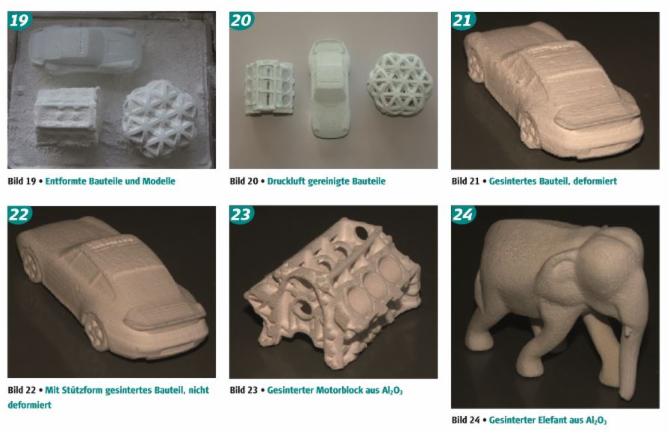3D-Drucken keramischer Bauteile


M. Schumacher, A. Grimm, R. Schüler Keram. Z. 62 (2010) [2]
3D-Drucken – RP-Bauteile mit richtungsabhängigen Eigenschaften
Zur Herstellung der keramischen Bauteile wurde als Rapid Prototyping Verfahren
das 3D-Drucken und als Maschine eine ZCorp ZP402 verwendet. Mittels
3D-Druckens war es möglich, keramische Modelle und Bauteile ausgehend
von CAD-Konstruktionen und 3D-Scans von Objekten herzustellen.
Verwendet wurden die verschiedensten keramischen Rohstoffe.
Die besten Resultate konnten mit Al2O3-Rohstoffen erzielt werden. Diese
wurden schließlich mit Schwerpunkt zur Analyse der Möglichkeiten des 3DDruckens
keramischer Objekte herangezogen. Da die klebende Komponente
nicht über den Canon-Druckkopf eingebracht werden konnte, wurde sie als
Trockenpulver in das keramische Pulver eingemischt. Die Druckerflüssigkeit
bestand aus Wasser als Hauptkomponente.
Erwartungsgemäß besaßen die gedruckten Bauteile eine dem schichtweisen
Aufbau und dem Zusammenkleben der einzelnen Granulate entsprechende
hohe Porosität, die ein recht geringes Festigkeitsniveau zur Folge
hatte. Verfahrenstechnisch bedingt waren die Eigenschaften der Bauteile
abhängig von der Orientierung des Bauteils im Druckraum. So ergaben sich
in z-Richtung des Schichtaufbaus die geringsten (σ0 = 5 MPa), in x-Richtung
des Druckerverfahrweges mittlere (σ0 = 10 MPa) und in y-Richtung des
Druckkopfverfahrweges die höchsten Festigkeiten (σ0 = 20 MPa).
Die technischen Einsatzfelder von 3D-gedruckten Keramikkörpern liegen
aufgrund der Eigenschaften z. B. in den Bereichen Filtration und Knochenersatz.
Auch sind Bauteilkonstruktionen machbar, die mit anderen traditionellen
Verfahren nicht zu erreichen sind. Weitere Einsatzmöglichkeiten dieser
Keramiken werden als verschleißfestere Kompositwerkstoffe nach Infiltration
mit Aluminium- und Bronze-Schmelze gesehen.
3D Printing – Rapid Prototyping Components with Properties Depending
on Orientation
3D Printing was used as a Rapid Prototyping process, using a ZCorp ZP402
printer, in order to manufacture ceramic components. By means of 3D
printing it was possible to produce ceramic models and components starting
from CAD constructions and 3D scans of the objects. Many different ceramic
raw materials were assessed, with the best results obtained for Al2O3
materials. These were ultimately used in order to analyse the capability of
3D printing in manufacturing ceramic objects. As the binder component
could not be introduced via the Canon printing head, it was blended into
the ceramic powder in dry form. An aqueous ink was used. As expected,
printed components displayed a high porosity, which is consistent with the
layer-by-layer construction method and the sticking together of individual
particles primarily within the layers. Thus a very low fracture strength resulted.
The properties of the components were dependent on their orientation
within the printing cavity. The smallest values were obtained in the zdirection
of the layer construction (σ0 = 5 MPa), with intermediate values
in the x-direction of the printer head movement (σ0 = 10 MPa) and the largest
values along y (σ0 = 20 MPa). Areas of technical application of 3D printed
ceramic objects, for example, are in filtration and bone substitution, as
a result of the porous properties. A main advantage of 3D printing is the
production of components, that cannot be made by traditional methods.
Further uses as wear-resistant composite materials, following infiltration
with aluminium and bronze melts are entirely conceivable.